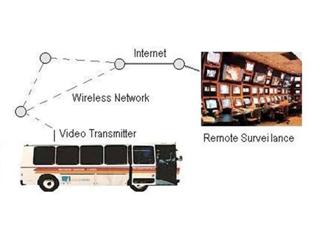|
The investigators have developed a real-time video surveillance technology for enhanced security on transit buses. The system uses digital cameras on buses, and adds a broad-bandwidth wireless network modem and unique software to expand the bandwidth for the wireless transmission of streaming digital video. The broad-bandwidth wireless real-time video surveillance system includes remote viewing, monitoring, and alerting functions at a transit central control room. Advanced data transmission and compression technologies have been used to extend the data bandwidth constraint.
Wireless networks extend the coverage of broadband services and provide ubiquitous network access to mobile devices. There are, however, many technical challenges to overcome before the vision of broad bandwidth networking can be realized. Video over wireless networks presents additional challenges due to the limited bandwidth available, the higher loss rates of signal strength, and the temporary periods of disconnectivity from the network. In order to make video streams feasible on mobile devices, new methods of wireless data transfer have to be designed.
This project was carried out by Carnegie Mellon University, with participation by the Port Authority of Allegheny County in Pittsburgh.
Results
Investigators have experimented with two wireless network infrastructures for mobile video streaming, including a Hot-Spot network that transmits video over existing 802.11b wireless hubs. The advantage of this method is that it would not need extra network facilities. Investigators have also experimented with the ad hoc network for video streaming that allows a network of mobile devices to communicate without centralized control. The mobile devices would dynamically detect and adapt routes to the other hosts in the ad hoc network. The advantage of this approach is that it would provide more flexible infrastructure for video streaming. Field tests and analysis show that the system design is feasible and economical. The prototype system can transfer the digital video at a resolution of 640 × 480 at a speed of more than one frame per second (fps). Based on existing wireless hotspots in an urban area, the prototype system can transfer video to a server on the Internet. Users can view the video on a computer with a web browser. Experiments also show that at the speed of 1 fps, the wireless network used less than 25 percent of connection capacity. The speed and format of video are compatible with what the Port Authority is using.
Product Payoff Potential
The real-time surveillance system will be able to enhance the security and safety of transit systems, especially in emergencies. The security and safety authorities could assess and respond to a situation instantly rather than wait until after it has happened. Also, automated face recognition systems could be considered as an option so that suspects could be tracked and reported in real-time. In addition, the potential for detecting unusual situations, such as medical emergencies or vandalism, could benefit transit agencies during their daily operations.
Product Transfer
The Port Authority of Allegheny County in Pittsburgh participated in this project by reviewing the development and proof of the concept and by participating in the technical development and testing. A final report was prepared by the investigators at Carnegie Mellon University, documenting the results of this project. Bombardier has contributed funds for adapting the technology for transit systems.

Figure 1
Illustration of the general concept.
The final report for this IDEA project can be found at:
https://onlinepubs.trb.org/onlinepubs/archive/studies/idea/finalreports/transit/Transit37_Final_Report.pdf.
|
|